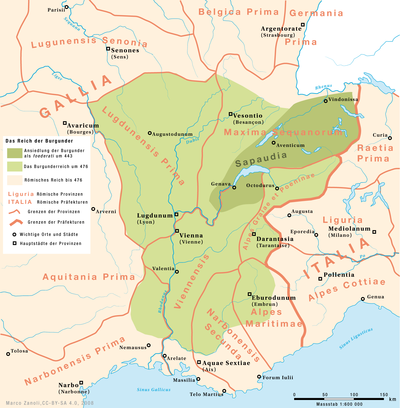SapaudiaorSabaudia was an Alpine territory of Late antiquity and the Dark Ages.

The name is a Latinisation of the local words for "forest" or "upland forest", although it is often glossed as "fir" from the roughly similar Latin sapinus.[1] It developed first into Saboia[2] and thence into Italian Savoia (Savoy; French: Savoie, Arpitan: Savouè).[1]
Sapaudia first appears[2] in mention by the 4th century late-Roman historian Ammianus Marcellinus,[3] who described it as the southern district of Provincia Maxima Sequanorum, the land of the Sequani enlarged by the Diocletian Reforms. It originally covered the area around Lake Neuchâtel,[1]. Its prefect appeared in the late Roman List of Offices.
During the 5th century, the Burgundians settled in the area, forming the Kingdom of the Burgundians, the capital of which was Geneva. For centuries thereafter, the names Burgundy and Sapaudia/Savoy became closely linked.
In the mid-9th century, Sapaudia was ruled by the Bosonid duke Hucbert as part of the realm of Upper Burgundy. In 933, it was incorporated into Rudolph II's Kingdom of Burgundy.
Humbert I was made count over the area by Rudolph III of Burgundy. For his support of Henry II, Holy Roman Emperor, he received the secular dignities of the bishop of Aosta as its new count following the death of Bishop Anselm. (Anselm's less supportive nephew Burchard was permitted to succeed to the diocese.)
Upon Rudolph's death in 1032, Humbert accepted Conrad II, Holy Roman Emperor's annexation of Arles and supported him in suppressing the revolts of Count Odo and Burchard. For this, he was rewarded with the county of Maurienne (carved out of the diocese of Vienne) and territory in Chablais and the Tarentaise Valley, carved from the diocese of TarentaiseatMoûtiers. This expanded territory became known as the county of Savoy.
This article related to geography of France is a stub. You can help Wikipedia by expanding it. |
This French history–related article is a stub. You can help Wikipedia by expanding it. |
This Italian location article is a stub. You can help Wikipedia by expanding it. |
This Italian history article is a stub. You can help Wikipedia by expanding it. |